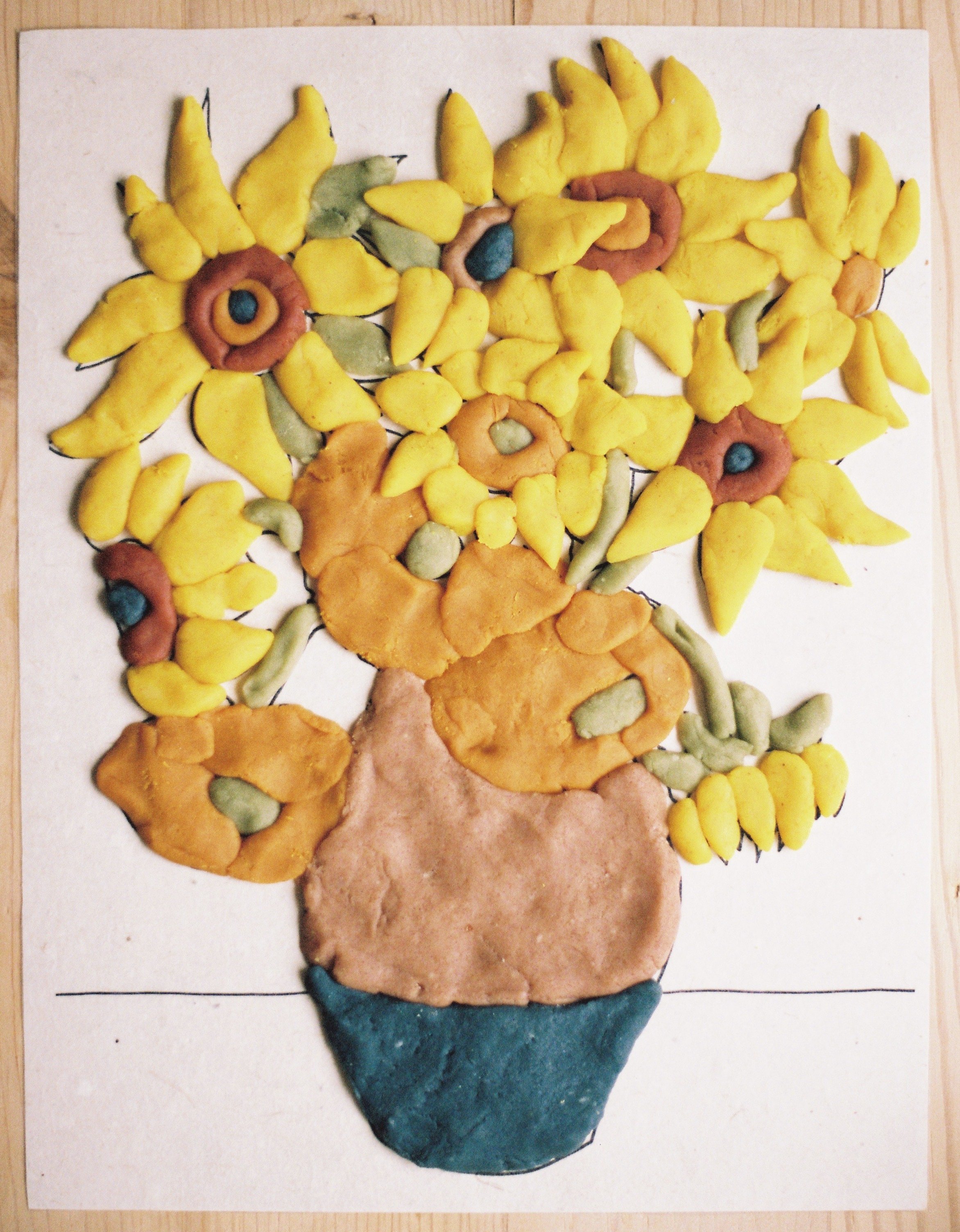
Who is Vincent Van Gogh?
LESSON 3
Children explore the life of the artist Vincent Van Gogh through an engaging story and participate in a play dough activity inspired by his famous sunflower paintings.
The book “Van Gogh and the Sunflowers,” by Laurence Anholt
Read aloud version here.
Play dough in multiple colors (homemade or store bought)
Sheet protector or laminator
Optional
Any book showcasing Van Gogh’s artwork. We found a book called “Van Gogh and the Sunflowers” by Louis van Tilborgh. Check your local library or online secondhand bookstores.
Materials
Gather materials
Read through the story beforehand
Preparations
Foster a supportive and engaging environment during the story reading.
Facilitate a thoughtful discussion about the importance of kindness and empathy.
Ask guided questions during the post-story discussion.
Organize and set up a designated space for the sunflower playdough activity.
Provide assistance and encouragement as needed during the playdough activity.
Objectives for Teachers
Children engage in active listening during the reading of "Van Gogh and the Sunflowers" by Laurence Anholt.
Children explore the theme of treating others with kindness through the story discussion.
Children participate in a post-story discussion, answering questions that promote critical thinking and comprehension.
Children express creativity during hands-on sunflower playdough activity.
Objectives for Children


Activity Flow
Find a comfortable place to sit down and read “Van Gogh and the Sunflowers” by Laurence Anholt with your child. Tell your child that this book is about an artist named Vincent Van Gogh who lived over 150 years ago, and you are going to learn a little bit more about his life in this story.
This is a great story to open up the discussion of why it is important to treat others with kindness.
*Just a reminder: children between the ages of 0-4 are in a stage of development where they are primarily focused on their own needs and desires. They have not yet fully developed the cognitive and emotional capacities necessary to consider and prioritize the feelings of others.
During this early stage of development, children are primarily driven by their own immediate needs and impulses. They are not yet capable of taking another person's perspective or understanding the impact of their actions on others. Their ability to empathize and consider the feelings of others is limited.
Additionally, young children at this age have limited language and communication skills, which further hinder their ability to understand and express emotions effectively. They may struggle to articulate their own emotions, let alone comprehend and respond to the emotions of others.
Between the ages of 5-7 (for sensitive children this can extend to age 9) children begin to undergo a significant developmental shift in their ability to consider other people's feelings while still being aware of their own.
During this stage, children start to develop a greater capacity for empathy and perspective-taking. They become more capable of understanding that others have their own thoughts, feelings, and perspectives, and they begin to recognize that their actions can affect those around them.
It is crucial for adults, such as parents and teachers, to provide guidance and support in helping children integrate their growing awareness of others' feelings with their own needs and desires. Adults can help children learn how to balance their own emotions and needs with understanding and respecting the emotions and needs of others.
Despite lacking the full capacity for empathy, we can lead by example, demonstrating kindness and empathy, and initiate meaningful conversations. Children can begin to practice and develop these essential skills.
Here are a few questions you can ask during or after the story, adjusting the question, or amount of questions based on their readiness:
When Camille’s father saw that Vincent had no money or friends what did he decide to do? (offered help, and gave him pots, pans, and furniture)
What did Camille do to start a friendship with Vincent? (picked him sunflowers)
What did Vincent do to return their kindness? (he painted portraits of them)
What did the children at school think of Camille's portrait that Vincent had painted for him? (they didn’t like the pictures and they laughed)
How did this make Camille feel? (very sad)
What did the children from school do to Vincent? (they teased him, and threw stones at him)
Did Vincent stop painting because people teased him? (no, he continued to paint throughout his life without getting much in return. He only sold one painting during his lifetime.)
Vincent painted the sunflowers Camille had given him, how did that make Camille feel? (happy)
After Vincent Van Gogh had passed away, what happened to his paintings? (now they are worth a lot of money, and many hang in museums for people to admire and feel inspired).
3. After your discussion about the story, get ready for some sunflower playdough fun! Set up a designated space for the activity and provide your child with playdough and the sunflower printable, inspired by Van Gogh's famous painting. You can reference the picture on the second to last page in the story. They can work on it either together with you or independently, depending on their preference and age.
For younger kids, it's recommended to print out the simplified version and offer a helping hand when needed. In my experience, my six-year-old preferred the simplified version but happily took charge of applying the playdough independently. Meanwhile, I worked on the more intricate version, and we had a blast working side by side.





